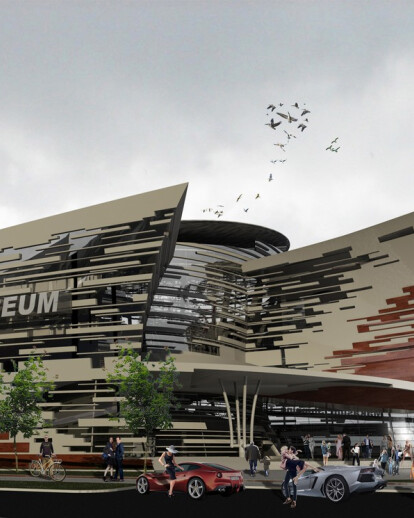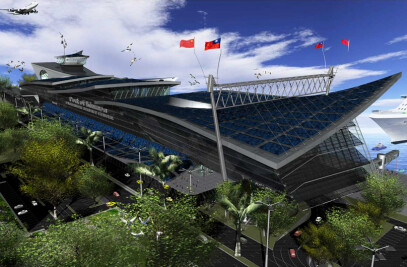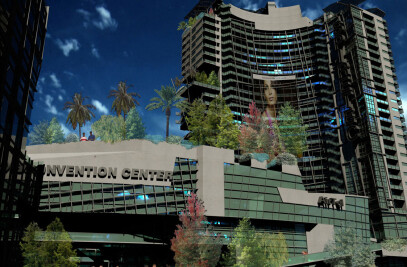Finland is rich in timberland with an extraordinary naturescape which its people hold dear and want to protect. Even clearly cultural development must keep this heritage intact and preserved for generations. This project expresses Finland's harmony between man and nature with this approach: The cold weather during the long winter covers the ground with snow, and for the abundant deer there is difficulty finding grass to eat. Instead, they pull strips of bark off the trees, and this, when abstracted, reflects in the facades of the Museum - each of them appearing as a portion of a tree trunk which was stripped of its bark. The smooth surface of the trunk has a little unevenness which expresses the natural process over Modern Architectural smoothness. The natural resource of wood, which is a hallmark of the country, is exposed on the elevations as random strips that continue on: The woodpecker, above the deer, pecks a hole in the trunk to build a nest – which is the exhibition. The multiplicity of these holes, simplified and made more appealing, dramatizes the Atrium space with a question: What will develop, and when to see it again?
The proximity of the Museum to open water is another resource expressed in this project: The gentle motion of the waves blend with the deep forest to form an unpredictable, surreal, and bold architectural vocabulary where everything is ready for a dramatic departure, for a new critical approach representing the theme of the exhibition and what it has to say.
The Museum itself is an adventure, with its artistic shape and unpredictable turns which are absolute sculpture on the landscape of the ocean front walk. All four views have their significance, but two of them are the most approachable - the North View which faces the Market Square, and the South View which faces Tahtitorninvoori Park where the main traffic occurs and from which the building can be seen from above and perceived more three-dimensionally. The shape of Guggenheim Helsinki divides in two on the north side to welcome the majority of its visitors and to provide a stunning view of the nearby government buildings and international institutions.
From the ocean side, the Museum has a Roof Garden which would provide a pleasant evening stroll and view of the harbor's graceful ocean liners. The south side the Museum incorporates the Makasiini Terminal, where travelers cannot miss seeing the museum. This is also the reason why the Café sits between both facilities – to bring users of the two facilities together. Travelers using the Terminal would find a little time to enjoy both their coffee and the view the Museum which they would never forget.
The Café corner is also associated with the Interior Garden, which lies in the divide of the building's north side, which is associated with the drop-off area and metered parking spaces. This Interior Garden is a focal point for visitors because it acts as a transitional area between their myriad interests and activities and the theme of the museum.
The Roof Garden has a direct connection with the ocean front walk, and joggers there definitely would use it as a challenging climb. It also has many periodically arranged seating areas for people to quietly enjoy the sculpture exhibitions. The many views of Helsinki would be magnificent there, a place not to be missed by visitors to the city.
Entrance to the Guggenheim Helsinki is from two sides - north and south. An Atrium, 34 meters high, opens with a pedestrian ramp connecting the ground level with the 9 meters high second level. Over the ramp is a bridge for visitors moving from the north exhibitions to the south exhibitions. This is the most dramatic space inside the Museum. The exhibition area is divided into several zones depending on the height of the ceiling needed: Some have a single floor-to-ceiling space, some have a two-floor height, and some rise even higher to the roof. It all depends on the kind of exhibition to be housed. The entire administrative area is on the north side of the Museum on multiple levels - they are completely separated from the visitor area and they have restricted access.
The project is extremely LEED sensitive and strictly meets the requirements of the program for Gold certification: Both Guggenheim Helsinki and Makasiini Terminal together use less than one third of the area of the site - 4109 SqM. In addition, there are high voltage solar panels on the roof to make the complex independent of the city's electrical grid. The Roof garden, in addition, replaces the area of land that the two buildings occupy and make the project more environmentally sensitive and protective.


































